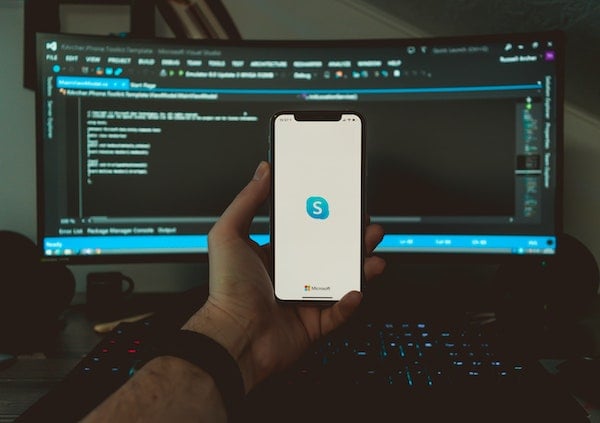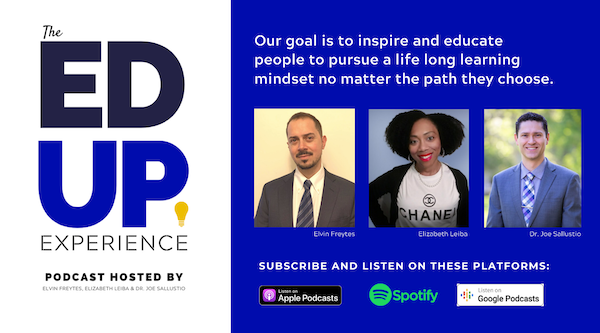Published on
Lifelong Learning: Adapting the Institution for Future Sustainability

With a pandemic altering higher education on a weekly basis, leaders are looking for ways to provide sustainability to their institution using their previous experiences. Now is the time to lean into lifelong learning and serve those who will remain loyal customers and are guaranteed to come back. In this interview, Joe Sallustio and Elizabeth Leiva from EdUp Experience speak to Philly Mantella to discuss her role as president during a pandemic, the importance of digital engagement and the decision-making behind rolling out specific programs that will provide a return on investment for students and workplace-readiness.
EdUp Experience: How have you ascended to the role of president at Grand Valley State University?
Philly Mantella (PM): It’s an interesting first year as a president, and it’s been a whirlwind ride. In regards to my career, I was a woman of the late ’70s. I went to school, and I didn’t consider a wide range of careers; I ended up choosing social work for my early college path. It turned out to be a great opportunity for me because that field both helps individuals and frames community and society with a systems-thinking approach. Experiential learning and vulnerable college populations is where I started.
In the beginning, I was on the enrollment, financial aid and student affairs side. I then broadened into academic innovation, adult and continuing education, and digital education at the end of my career at Northeastern University before I joined Grand Valley. That previous experience helped me understand what a presidency would be like when you’re responsible for the institution as a whole.
Fortunately, at Northeastern there was a lot of freedom and opportunity to experiment. When Grand Valley reached out to me, I knew I had to be extremely passionate about the place I would lead. The president’s life is 24/7, and I knew that I wanted and had to live and breathe the work of an institution I truly believed in.
EdUp Experience: You’re very active on social media, particularly LinkedIn—why is it important to be active in communicating on social media?
PM: If you look at my trajectory, I’m a lot more active in this role than I’ve been at previous institutions. The biggest part of the “why” for me is that I started looking at the landscape of higher education very differently coming out of the innovation space. I started to really think about the kinds of institutions that have the capacity to excel. What do we need, what is the framework needed to help move education forward? So, I came to a public institution in Michigan and Michigan’s structure is independent in terms of its organization via its boards and governance. We are unique and tend to make different choices across what many people will see as a state system in other places.
When I get asked about how the pandemic has changed the vision of higher education going forward, I often answer that the vision is the same, but the pace has accelerated, and the stakes are higher. The things that drew me here and the reasons I write about it haven’t gone away, they’re still very much present. For example, say an institution is only 60 years old, and its tuition price point is about $13,000. It runs and delivers education with a deeply interactive faculty model, holistic faculty support for the students. The campus is focused on the quality, detail, care and concern—whether it’s people or facilities.
I believe the city of Grand Rapids is the second most philanthropic city in the U.S. and that philanthropy is extended by the university. So, there’s this strong commitment as a public/private partnership for education. And it’s not someone else’s responsibility; it’s up to the federal and state governments to fund, to people who pay their own tuition, the state to fund. It is truly an institution that is sponsored by many of those stakeholders. It’s a very change-abled place.
Higher education competes to its own detriment. We hold our cards close to us because student populations decrease when financial pressures increase, and we have to compete. The public loses the most in this. If you look at education and the needs for new competencies and engagement strategies, there’s plenty of room for everyone. But we’re all confined in this very narrow space. Grand Valley has a broader frame for education and the demographic details about who’s ready for college and how deep you go into K-12 in order to scaffold folks into college.
We all know we’re competitors, and I’m a fierce competitor on my own, but we can’t compete to the public’s detriment—to keep narrowing our scopes to elevate our institution. It’s about achieving equity in education. To see opportunity in this very difficult moment is to move the things where we need them. There’s room for many institutions to take that broader frame and begin to work in educational methods across higher education. That’s what really excites me.
EdUp Experience: When it comes to the shrinking demographic especially in today’s environment, how does your background in enrollment management allow you to strategize in a different way as a president—what advice do you have for others without that experience?
PM: The benefits of an enrollment background starts with the market. Education has to take an outside-in perspective versus an inside-out perspective. We have offerings that we want to push to the public, but what is it that people need and how do they learn? True enrollment management is about understanding the learner and the market. And you have to be honest with yourself about your institution’s strengths and weaknesses and then figure out how to fit those into the learner and market needs.
A good strategy is needed to make choices around market demands that will also optimize your institution and its learners. It’s key to have a graduation mindset rather than an enrollment mindset. Traditionally, presidents would come out of academic faculty or finance; you would hardly ever see someone come from an area like enrollment or student affairs. But enrollment is an interesting preparation and, in some ways, job one for presidents. It’s where the bulk of sustainability is. Playing many roles allows you to know to ask the right questions. It’s useful to be able to challenge one another, then experiment.
When it comes to advice, I would say to spend time trying to understand the faculty culture: the life of a faculty member, the challenges they face in preparing a course online, in person and in hybrid mode because it can be a lot to handle. Get a 360-degree view to understand our colleagues’ experiences to become a better and stronger leader.
EdUp Experience: Being the first female president at your institution, what advice would you give to women working in higher education who aspire to leadership roles but aren’t sure how to navigate that path?
PM: First, find the very best thought partners you can find and have them be people that think differently from you and who will challenge you. Sometimes women want to feel that they’ve got things in hand and that they’re just as competent as the men around the same table. That’s great, but sometimes that can lead us to be reluctant and vulnerable—I know I was. The most important element of my leadership was having smart men and women around me who would help me reflect on my journey and push my own thinking.
EdUp Experience: How do you feel fundraising has been or will be changed going forward?
PM: Fundraising has to be a concern for a variety of reasons. Experiencing this pandemic has made us reassess what our greatest needs are. It could be healthcare; it could be the digital divide that exists being personified. Will that take more philanthropic dollars and investments, or are people going to preserve their own wealth for a period of time as their returns recover?
Where people put their dollars crosses industry and is more about giving money to a cause important to that individual. If an institution truly cares about the larger issues highlighted by COVID-19, or in the recovery of higher education–even in the state’s economic recovery–they’ll come up with good ideas and solutions. We’re finding ways to have multiple contributors, and the resources will come.
EdUp Experience: What has been a significant change for you as a leader during this pandemic and what have you done to adapt?
PM: This institution has a very positive culture, but the culture of leadership was much more siloed. People really delegated responsibility and divided it according to zone or area. I’m much more of a network leader, where I like to follow where the energy is. It’s not a leadership that has to organize and lead people down a prescribed path. For me, my job is to unleash energy to try to discern whether that idea, experiment or program has the potential to make a meaningful difference.
Higher education is not ready, fire, aim. It’s reversed. It’s aim, fire, ready. We have a program concept for which we hire tenure-track faculty, then we go into the market with it and find whether it’s right or wrong. You can’t have chaos, so we have to figure out how to organize that energy, determine the idea behind it, advance it and move forward.
With COVID-19, if you have a culture that is somewhat siloed when it comes to leadership and management, you can’t have that. I came from a very different culture with a different set of leadership principles. At the time, I’m sure I was shocking the system because I was creating acceleration teams. People were scratching their heads wondering why a president was getting a variety of people to work on a certain initiative. We had conversations about how to lead and use the best of our differences. All of a sudden, we’re in this pandemic situation that requires all hands-on deck.
We have to deploy and activate. We have to rely on people across the institution, particularly if we’re going to lead with clarity, driven by our core values, and as decisive as we can be quickly. In any crisis, you have to work at pace and have a networked culture. The pandemic automatically showed the values, doubts and challenges of a more distributed network environment that has to be organized for effective decision-making.
EdUp Experience: What are some of the factors that weigh into rolling out specific programs and how has that changed as we think about return on investment for students and workplace readiness?
PM: Coming into Grand Valley, I knew the institution did incredible educational work but largely with traditional students, which is a declining demographic, and education needs to focus on lifelong learning. We needed to look at the adults who had some college credits without stepping on the great work that community colleges were doing. We looked at Michigan adults with some postsecondary education and started to map them to the locations public policy issues in Michigan where the governor was articulating.
Michigan had about a 38% completion rate when it came to bachelor’s degrees. The U.S. average was 45%, and the governors’ goal was 60%. Again, it’s about that outside-in approach. So, we conducted a market study to see what was in most demand and who the employers were and what they needed.
From there, we worked with the governor to understand her goals and look at what level of degree completion public institutions were completing. We weren’t able to reach her goal within her given timeframe, so we mapped it back into the institution. It was then that we found we had an accelerated interdisciplinary degree that was delivered by a faculty group and a cohort-based model that was constrained in size.
We wanted to approach it differently and morph it into a more scalable model. Experiential learning and success coaching were all a part of this program; we just wanted to do it on a larger level. If there was an emphasis in the program, we wanted to take that and make it a certificate aligned with the professional skills gap. It was then that we had something. We just had to look from the outside-in and be really conscious of not just building in spaces where we were creating redundancy.
We all know students will be challenged with internships, co-ops and experiential learning, so we recently announced SE+ (Student Employment Plus). At Grand Valley, we have student employees everywhere and it’s more important than ever for us to keep our student-centered culture. What we wanted to take student employment and build experiential learning into it. This challenges supervisors to not just place students in jobs that are convenient for them but to see where they can thrive. We wanted to enrich the jobs, create a framework for them to think about how their skills are translating and give them an opportunity to earn credit and money. So that’s our pilot project right now, and it relates back to working with the problem. What is the problem, what’s the asset, and how do you create creative and different map?
EdUp Experience: Is there anything that you would like to leave our audience with regarding Grand Valley State University and what you’re doing there? And secondly, what do you think the future of higher education will look like?
PM: Grand Valley has a big vision, and we want to make a big contribution in higher education. I’ve written down in my office the phrase “The best is yet to come,” and it just reminds me that as difficult as this time is, the pain ahead is going to be substantial for people both in higher education and outside of it. There will be closures and consolidations; schools on the brink that had liquidity challenges are facing very difficult times, but it’s going to press us.
One day we could be discussing the pros and cons of digital learning, and the next day faculty say they prefer digital learning because they feel safer and know it’s of high quality, then that’s pushing us to the best of digital education. Hopefully we’ll see how face-to-face learning itself is a precious asset that shouldn’t be wasted.
The equity issue can be addressed with some level of focus on how we get out of the supply chain mentality and into the personalization of education. Everybody is going to need to flex a little differently coming out of this crisis. Some of us have not been impacted personally, but others have been faced with distraction because they need to take care of family members. Others want and need that immersive college experience again, and these are the areas we need to focus on. Let’s bring the best of the digital world and face-to-face education forward and try to get out of this supply chain mentality to allow everyone to be included.
This interview was edited for length and clarity.
Listen to the full interview here.

Author Perspective: Administrator



